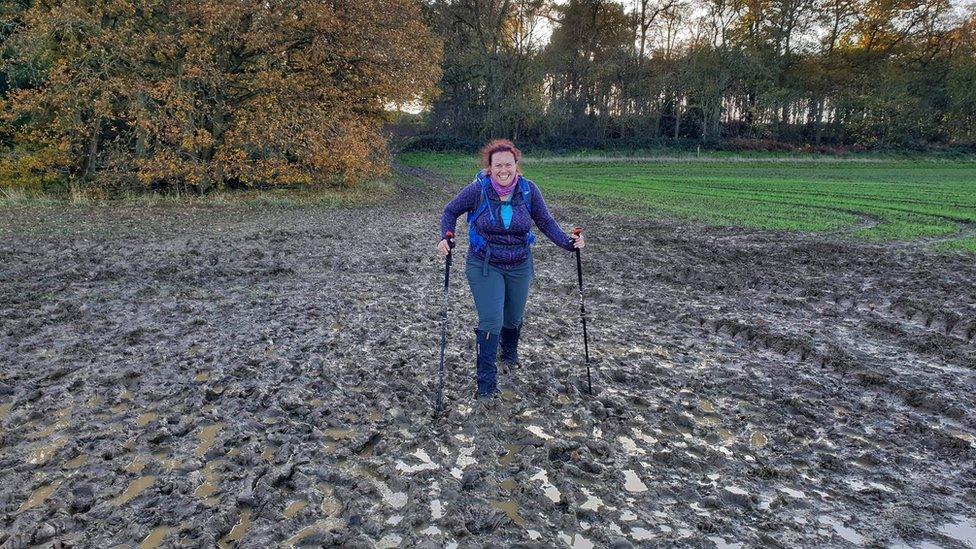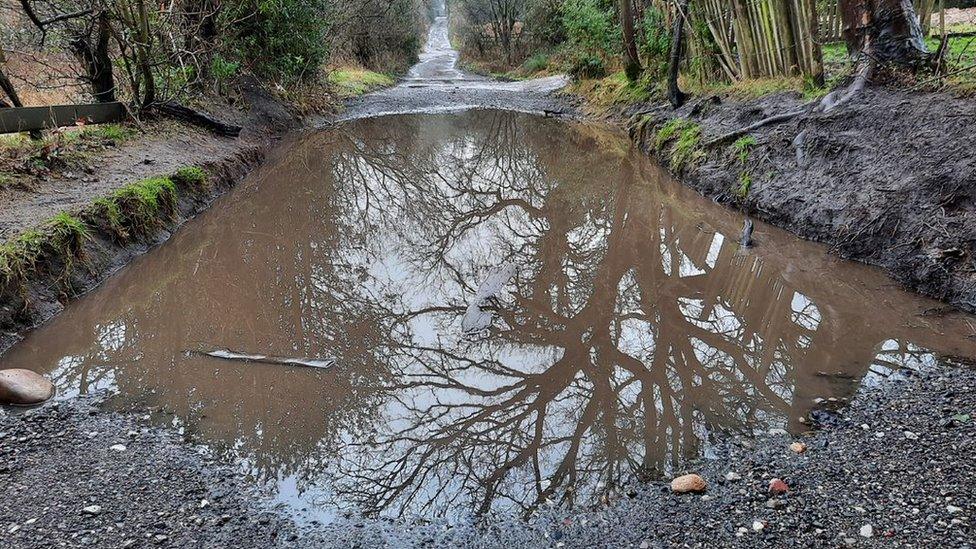Walking paths have become bogs and need repair, says charity
- Published

Rambler Rebecca Dawson says many popular paths have been overwhelmed
Many of England's paths have become impassable with flooding and erosion because of the increase in foot traffic in 2020, a walking charity says.
The Ramblers say more people took to walking during the lockdowns, causing deep mud and boggy conditions.
The charity is now calling on Chancellor Rishi Sunak to include a "vital" emergency repair fund in the Autumn Budget.
The government said it would not be drawn ahead of the statement next week.
Last year, people in England made 32% of all their trips on foot compared to 26% in 2019, according to statistics from the Office for National Statistics, external.
And miles walked per person increased to their highest levels since 2002, says the ONS.
As a result of this increase, and wet weather, the Ramblers received 203 reports of muddy or waterlogged paths between October 2020 and March 2021.
This was almost one per day - double the number just 12 months earlier.
Mr Sunak is to deliver his statement on 27 October, when the Ramblers hope to see a financial commitment to maintain popular routes.
Alan Manning, 70, a volunteer with the Greater Manchester Area Ramblers, told the BBC that the charity wants walking to continue to be popular but paths were now "badly eroded" across the country.
Mr Manning said many were "very difficult to walk and at times impassable" because of flooding and deep mud, which reduced accessibility.
This was particularly the case for those with mobility difficulties or families with young children, he said.
The charity has not committed to a specific figure for the Budget but says it wants the statement to recognise that additional cash is needed for councils to fix the walkways.

There are concerns that the winter months will only worsen the situation
Mr Manning said: "There will be different solutions for different locations - we'd want the final product to be weather-proof, accessible for people with a range of abilities, easy enough to push a double buggy through.
"Then, depending on location, you might need foundations, a smooth surface, or gravel."
Although the condition of some paths has improved during the summer months, the Ramblers said, there is a concern that the onset of wetter weather will see the paths degrade further and cause a "winter of misery".
Hannah Price, a parish councillor in Buckinghamshire, who contacted the Ramblers for help in February said: "I met one woman whilst out walking who said she'd been too frightened to use some of the paths in our parish for fear of getting stuck in the mud on her own."
And Rebecca Dawson, chair of Stag Walkers Ramblers group in Hertfordshire, said: "Some paths became bogs that swallowed walking boots and wellies, while others were widened artificially by people avoiding the worst of the mud - impacting on the surrounding vegetation, including crops."
A report by The Ramblers, external in 2020 found 45% of adults intended to walk more after coronavirus restrictions lifted to improve their physical health and 42% wanted to continue walking for leisure reasons.
Tompion Platt, director of advocacy and operations for the Ramblers, said: "Now is the time for government to invest in our paths and show a commitment to build on the momentum of more people walking.
"A relatively small investment would help protect the places we love to walk and enable people of all abilities to safely enjoy the benefits of walking in nature. It will pay for itself many times over in health and wellbeing benefits."